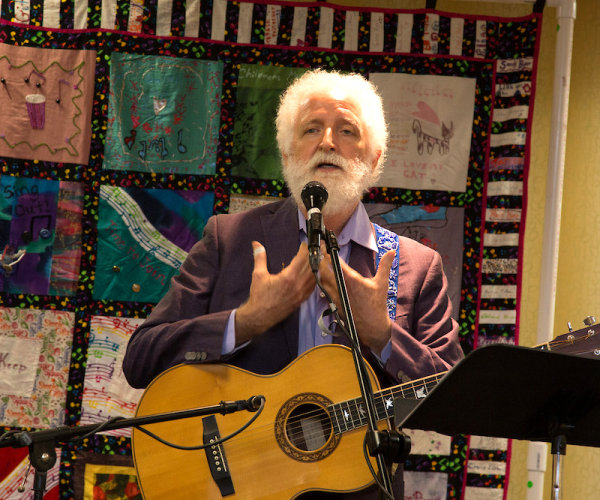
Conference Keynote
Ken Whiteley
by Sandy Byer
Canadian performer, multi-instrumentalist, singer-songwriter, and award-winning record producer Ken Whiteley presented a delightful and informative keynote address at the CMN national gathering in Hyannis, Massachusetts this past October. Ken began his program by leading us in the old gospel song, “You Gotta Sing When the Spirit Says Sing.” This illustrated the importance of singing together in order to strengthen vital connections, build community, and foster acceptance of self and others. He emphasized that teaching what is familiar, creating the opportunity for emotional openness through improvisation, and focusing on the ultimate connection we all share by speaking to spirit were inherent in that zipper song, and that zipper songs in general are designed to connect with people right away.
Then Ken shared some of his history with us. His grandfather was a bandleader and his stepfather was a musician. He sang the song “Family Tree” about his grandfather, and talked about the importance of memory and how things are passed along. Ken and his older brother Chris started recording when Ken was fourteen years old. He spoke about running a coffeehouse where he composed new songs every week, learning to trust his ears when accompanying a song, and making artistic decisions.
He spoke about his work learning how to program the Mariposa Folk Festival and his time spent performing through Mariposa In The Schools (MITS). He found that performers in MITS shared ideas, and said that working in schools was exhilarating, challenging, and rewarding. Ken had fun and the kids had fun. Whether he worked in bars or in schools, he learned that audiences had to be engaged and it was his responsibility to engage them.
Then he spoke about his first collaboration with Raffi on “Singable Songs for the Very Young.” Raffi called Ken up and asked him to produce the recording, which was made at Daniel Lanois’s studio. Raffi’s wife, Debbie Pike, and their friends, the Simpsons, chose the repertoire. Ken’s job was to write the arrangements and select the musicians in addition to singing and playing on the recording.
Ken discussed his evolution as a record producer, then delved into what the job entails—the collaborative process between producer and artist, starting with musical ideas and song choices that fit the whole and hang together. The producer helps an artist make the best recording—and performance—possible. On each song cut, he or she works to focus the artist, to showcase the material in the best possible way, and to ensure that the artist and the material are both making connections with the audience.
Ken mentioned that a recording is not the same as a live performance, particularly because people only hear a performer on a recording. So the producer needs to enhance the auditory experience while preserving the character of the artist. He illustrated this by performing his song “Leaves,” and then playing a recording of that song. On the recording, Ken paints auditory pictures in order to make a connection with the listener. The accompanying layers of additional music set the tone and affect how the song sounds and feels to an audience. Over the years he has learned about the science of sounds, which helps him in fitting everything together.
Then Ken turned to the new recording he had recently made with CMN member Kari Kovick, It’s You I Like. He played some raw audio from the song “Two Little Blackbirds,” which captured the immediacy of Kari singing in a room with young kids. Then he compared that recording to the mixed version. He spoke about the importance of creating trust and rapport in building a relationship with an artist, and discussed the importance of an artist being energized to generate the best performance. He believes that every artist is unique, and to encourage the best performance, a producer needs to adapt and adjust to every situation, be light on their feet, and be open and willing to respond in the moment.
More singing followed. Ken shared the song “Big Wheel, Little Wheel,” which illustrated interconnecting wheels, part of a project designed for a science program. He then turned his attention to Bessie Jones and the Georgia Sea Island Singers. Bessie Jones had a great influence on Ken, and he shared some of her history, play party songs, shouts, and spirit of universal affirmation.
Ken spoke eloquently about the spiritual connections that can be made at so many levels through the songs we share. He illustrated the point with his song “Let My Life Be Prayer,” which is about connecting with what is bigger than ourselves and transcends time or linear space.
Ken closed by saying that it was a privilege to lead others in song, as singing together co-creates circles of positive energy. He ended his wonderful presentation by leading us in one more of his songs, “Sing With Me,” which took us full circle back to the beginning. We sang together, building community and strengthening connections—the very essence of CMN. What a treat!
Conference photos by Kayte Deioma